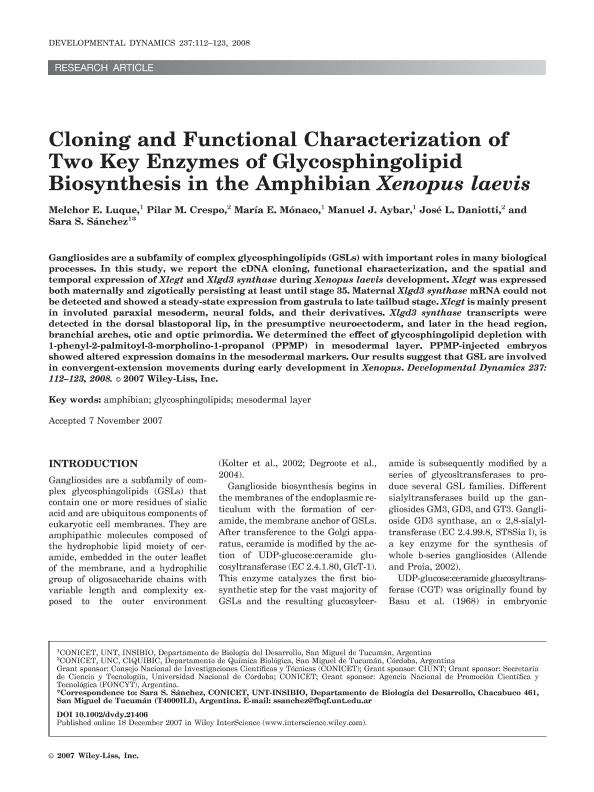Artículo
Cloning and functional characterization of two key enzymes of glycosphingolipid biosynthesis in the amphibian Xenopus laevis
Luque, Melchor Emilio ; Crespo, Pilar María
; Crespo, Pilar María ; Mónaco, María Elvira
; Mónaco, María Elvira ; Aybar, Manuel Javier
; Aybar, Manuel Javier ; Daniotti, Jose Luis
; Daniotti, Jose Luis ; Sanchez, Sara Serafina del V.
; Sanchez, Sara Serafina del V.
 ; Crespo, Pilar María
; Crespo, Pilar María ; Mónaco, María Elvira
; Mónaco, María Elvira ; Aybar, Manuel Javier
; Aybar, Manuel Javier ; Daniotti, Jose Luis
; Daniotti, Jose Luis ; Sanchez, Sara Serafina del V.
; Sanchez, Sara Serafina del V.
Fecha de publicación:
01/2008
Editorial:
Wiley-liss, Div John Wiley & Sons Inc
Revista:
Developmental Dynamics
ISSN:
1058-8388
Idioma:
Inglés
Tipo de recurso:
Artículo publicado
Clasificación temática:
Resumen
Gangliosides are a subfamily of complex glycosphingolipids (GSLs) with important roles in many biological processes. In this study, we report the cDNA cloning, functional characterization, and the spatial and temporal expression of Xlcgt and Xlgd3 synthase during Xenopus laevis development. Xlcgt was expressed both maternally and zigotically persisting at least until stage 35. Maternal Xlgd3 synthase mRNA could not be detected and showed a steady-state expression from gastrula to late tailbud stage. Xlcgt is mainly present in involuted paraxial mesoderm, neural folds, and their derivatives. Xlgd3 synthase transcripts were detected in the dorsal blastoporal lip, in the presumptive neuroectoderm, and later in the head region, branchial arches, otic and optic primordia. We determined the effect of glycosphingolipid depletion with 1-phenyl-2-palmitoyl-3-morpholino-1-propanol (PPMP) in mesodermal layer. PPMP-injected embryos showed altered expression domains in the mesodermal markers. Our results suggest that GSL are involved in convergent-extension movements during early development in Xenopus. © 2007 Wiley-Liss, Inc.
Palabras clave:
Amphibian
,
Glycosphingolipids
,
Mesodermal Layer
Archivos asociados
Licencia
Identificadores
Colecciones
Articulos(INSIBIO)
Articulos de INST.SUP.DE INVEST.BIOLOGICAS
Articulos de INST.SUP.DE INVEST.BIOLOGICAS
Citación
Luque, Melchor Emilio; Crespo, Pilar María; Mónaco, María Elvira; Aybar, Manuel Javier; Daniotti, Jose Luis; et al.; Cloning and functional characterization of two key enzymes of glycosphingolipid biosynthesis in the amphibian Xenopus laevis; Wiley-liss, Div John Wiley & Sons Inc; Developmental Dynamics; 237; 1; 1-2008; 112-123
Compartir
Altmétricas



